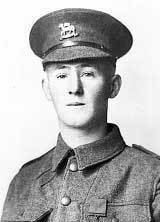Name Leonard Keyworth | Unit London Regiment Battles and wars World War I Years of service 1914 - 1915 Role Armed force officer | |
 | ||
Similar People Jack Harvey, Arthur Borton, Arthur Henry Cross | ||
Leonard James Keyworth VC (12 August 1893 – 19 October 1915) was an English recipient of the Victoria Cross, the highest and most prestigious award for gallantry in the face of the enemy that can be awarded to British and Commonwealth forces.
Contents
Details
Son of James and Emma Keyworth, of Lincoln. He was a Lance-Corporal in the 24th (County of London) Battalion, The London Regiment (The Queen's), British Army during the First World War.
On 25/26 May 1915 at Givenchy, France, 21-year-old Keyworth performed an act of bravery for which he was awarded the Victoria Cross. Others involved in that incident were Captain Donald Figg and Private Herbert John Hodgson. Keyworth was also awarded the Medal of St. George (2nd Class) of Russia.
Citation
For most conspicuous bravery at Givenchy on the night of 25-26th May, 1915. After the assault on the German position by the 24th Battalion, London Regt, efforts were made by that Unit to follow up their success by a bomb attack, during the progress of which 58 men out of a total 75 became casualties. During this very fierce encounter Lance-Cpl Keyworth stood fully exposed for 2 hours on the top of the enemy's parapet, and threw about 150 bombs amongst the Germans, who were only a few yards away.
He later achieved the rank of Corporal, but was killed in action, Abbeville, France, on 19 October 1915.
Further information
This medal is currently in a private collection.
